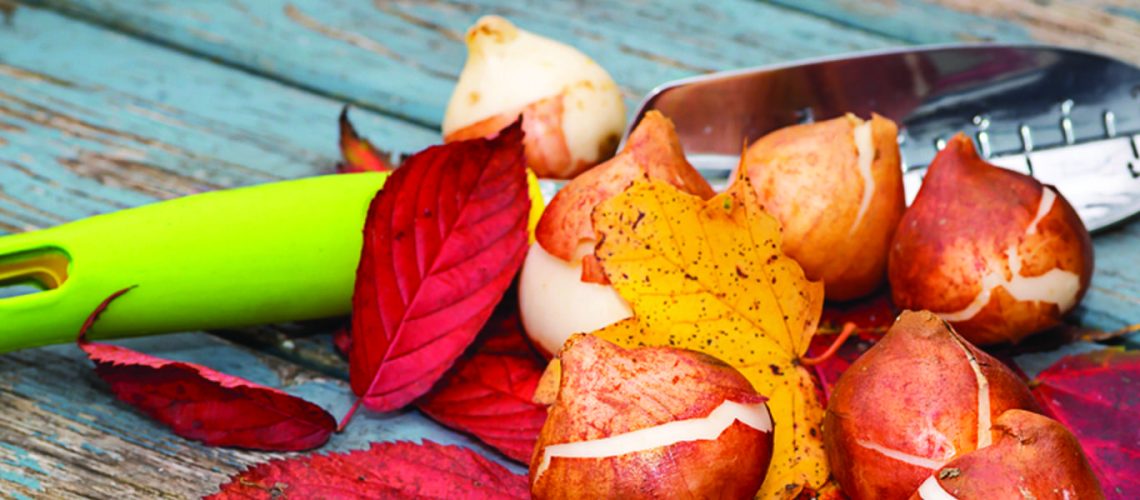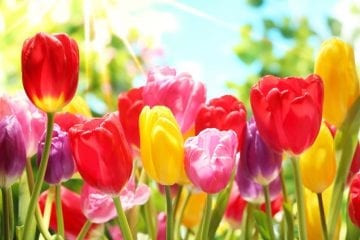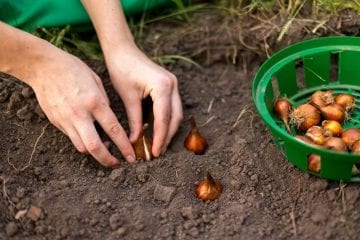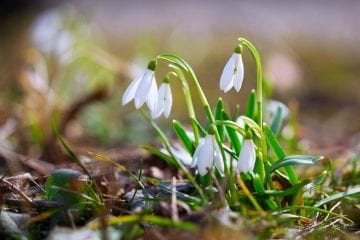- SHOP ONLINE
- AT THE GARDEN CENTRE
- BE INSPIRED
- LANDSCAPE SOLUTIONS
- EMPLOYMENT
- ABOUT US
Menu
- SHOP ONLINE
- AT THE GARDEN CENTRE
- BE INSPIRED
- LANDSCAPE SOLUTIONS
- EMPLOYMENT
- ABOUT US

How many of us love the beauty of spring colour just as the snow is melting and the earth is starting to warm up again? The sight of beautiful crocuses or daffodils after the long winter is hard to beat – and one of the best parts is the little amount of effort it takes to accomplish this beauty! In the fall, when the weather is still warm and the ground is soft, plant a few fall bulbs and when spring rolls around, you’ll be happy you did!
Fall bulbs are given their title according to what season you plant them in. Spring bulbs are planted in the spring, and bloom in the summer and fall; fall bulbs are planted in autumn and bloom in the spring. Between the months of September and November, you can be planning and planting for your spring garden with your fall bulbs!
 In many ways, bulbs are curious things. We plant what looks like a kind of onion in the ground, and without much more thought or additional help from us, they spring from the ground on their own timing with glorious bursts of colour! How do they survive the cold winter having only been planted just beforehand? How do they have enough energy to produce such beautiful blooms only shortly after the snow?
In many ways, bulbs are curious things. We plant what looks like a kind of onion in the ground, and without much more thought or additional help from us, they spring from the ground on their own timing with glorious bursts of colour! How do they survive the cold winter having only been planted just beforehand? How do they have enough energy to produce such beautiful blooms only shortly after the snow?
Bulbs have a miraculous ability to be self-sufficient. Spring blooming bulbs require a certain amount of chilling time, the cold temperatures acting as a catalyst for biological processes that lead to their growth and bloom. They will develop a small amount of root growth before the winter and perhaps begin to push a sprout to the top of the soil, but stop before it breaks the soil. They will use the cold winter to gather and store energy, waiting for the warmer weather in spring before fully expelling its energy and growing. Because of their hardy nature, they can handle the warm spring weather followed by a cold snap – so don’t panic if the weather bounces around in the spring! Bulbs can usually handle the weather Mother Nature sends without any help from us.
While each bulb has different requirement, a good general guideline for planting bulbs in our area is towards late September and into October. If you plant bulbs too early, when the weather is still very warm, your bulbs may think it’s spring and put energy into blooming, if you plant them too late, you won’t be able to give them the time to get established before the frost hits. Because each variety of fall bulb has different requirements, it is always a great idea to follow the directions on the packaging of your bulbs. It will outline planting depth, time, watering, and any other keys to successful planting. In general, however, you can follow these guidelines:
 Dig a hole approximately 7”-9” deep for larger bulbs (tulips, daffodils, iris) and approximately 4”-6” for smaller bulbs. The bulbs should be planted 2-2.5 times the depth of the bulb.
Dig a hole approximately 7”-9” deep for larger bulbs (tulips, daffodils, iris) and approximately 4”-6” for smaller bulbs. The bulbs should be planted 2-2.5 times the depth of the bulb.One of the greatest things about fall bulbs is the endless list of designs, colours, and patterns you can make with them! Plant bulbs to line your walkway, in gardens near your front door to welcome you home on spring days, or try planting them in containers! Don’t be afraid to experiment with different heights, colours, and varieties – go for layering looks or uniform colour for a strong burst of colour. Planting bulbs in clusters works well if you’re looking to make the most dramatic and full display possible.
If you want to plant your bulbs in containers, they require extra care, but it’s well worth the effort when you have portable, gorgeous blooms to add life to your gardens for the spring season! For advice and care instructions for planting and caring for fall bulbs in containers, be sure to let us know! Our Royal City Nursery experts can make sure you have all the information and supplies to plant beautiful bulb planters!
 Some of the most common bulb categories that people love are:
Some of the most common bulb categories that people love are:
Within these categories, there are various kinds, and exploring your different options is just part of the fun of planting fall bulbs.
For any other supplies or advice, feel free to stop by or drop us a line today!
HOURS
JOIN US YEAR-ROUND!
Hours of Inspiration
Monday to Friday: 9am – 6pm
Saturday: 9am – 5pm
Sunday: 10am – 5pm
BE INSPIRED
Sign up for our E-Newsletter to receive garden tips, landscaping advice and more, delivered right to your inbox.
Sign up today!
Find Us